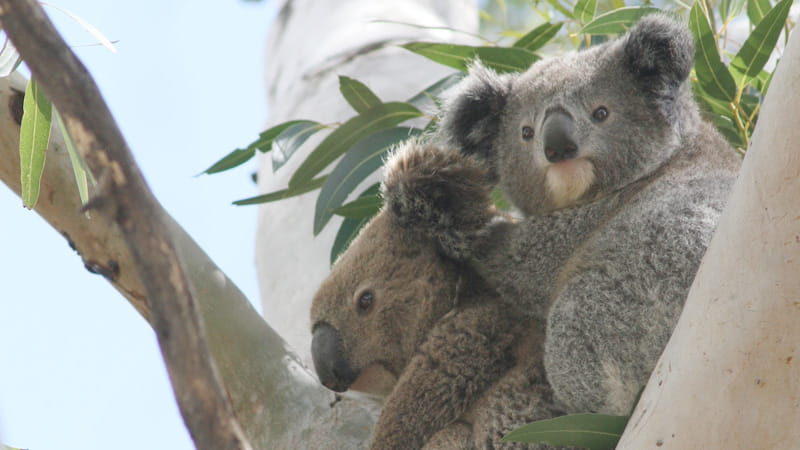Nymboi-Binderay National Park
Overview
Nymboi-Binderay National Park offers spectacular scenery along the Nymboida River for experienced kayaking and white-water rafting enthusiasts. Camp out on a weekend trip.
Read more about Nymboi-Binderay National Park
The Nymboida River runs through the heart of Nymboi-Binderay National Park, making it a popular destination for intrepid white-water rafters and kayakers. A short section of the river at Platypus Flat is suitable for swimming, otherwise the river is for experienced white-water paddlers only.
Although rafting is the best way to fully appreciate the park’s stunning beauty, Moonpar Forest drive offers an alternative option while experienced bushwalkers will love exploring the park’s landscape on foot along unmarked trails, through tallowwood trees and coachwood rainforest. It’s a great place to escape to nature for the weekend.
The stunning rainforests and extensive old forests in Nymboi-Binderay provide a habitat for a variety of threatened animals like the powerful owl, stuttering frog as well as the more common koala and kookaburra. Plus, amongst the park’s 55 metre tall eucalypts, you’ll discover the remnants of the early timber industry and historic days of the axe, crosscut saw and steam tramways.
Local alerts
For the latest updates on fires, closures and other alerts in this area, see https://www.nationalparks.nsw.gov.au/visit-a-park/parks/nymboibinderay-national-park/local-alerts
Map
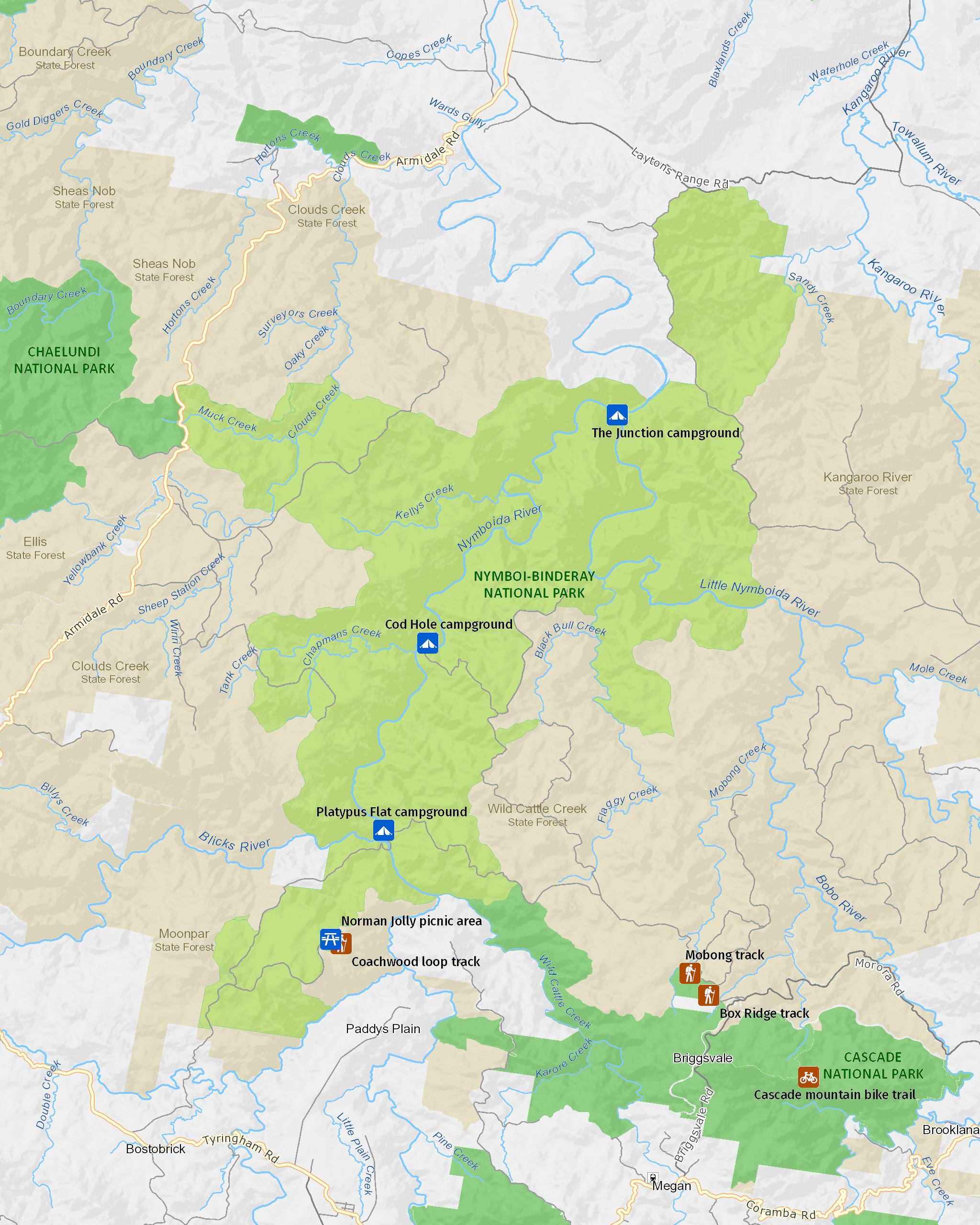
Map legend

Contact
- in the North Coast region
Nymboi-Binderay National Park is always open but may have to close at times due to poor weather or fire danger.
-
-
Coffs Harbour office
02 6652 0900
Contact hours: Monday to Friday, 8.30am to 4.30pm. - 4/32 Edgar St, Coffs Harbour NSW 2450
-
Email: npws.coffscoast@environment.nsw.gov.au
-
Coffs Harbour office
-
-
Grafton office
02 6641 1500
Contact hours: Monday to Friday, 8.30am to 4.30pm. - Level 4, 49 Victoria Street, Grafton NSW 2460
-
Email: npws.clarence@environment.nsw.gov.au
-
Grafton office
Visitor info
All the practical information you need to know about Nymboi-Binderay National Park.
Getting there and parking
Get driving directions
From Nymboida travel south for 2km, and turn left into Laytons Range Road. Black Mountain Road is 5.5km on the right. Access to The Junction camping area requires 4WD.
Parking
- Cod Hole campground and picnic area See on map
- Platypus Flat campground See on map
- The Junction campground See on map
By bike
Check out the Bicycle information for NSW website for more information.
Best times to visit
There are lots of great things waiting for you in Nymboi-Binderay National Park. One of the highlights of a visit to the park is a whitewater rafting trip down the Nymboida River. Spring is a great time to head out on a guided tour.
Weather, temperature and rainfall
Summer temperature
Average
18°C and 29°C
Winter temperature
Average
5°C and 20°C
Rainfall
Wettest month
March
Driest month
August
The area’s highest recorded rainfall in one day
388mm
Facilities
Toilets
- Cod Hole campground and picnic area
- Norman Jolly picnic area
- Platypus Flat campground
- The Junction campground
Picnic tables
- Cod Hole campground and picnic area
- Norman Jolly picnic area
- Platypus Flat campground
- The Junction campground
Barbecue facilities
Boat ramp
Maps and downloads
Prohibited
Pets
Pets and domestic animals (other than certified assistance animals) are not permitted. Find out which regional parks allow dog walking and see the pets in parks policy for more information.
Smoking
NSW national parks are no smoking areas.
Nearby towns
Dorrigo (20 km)
Dorrigo is a serene country town and the gateway to Dorrigo National Park. Its close to the edge of the escarpment above the Bellingen Valley.
Bellingen (49 km)
Bellingen is a laid-back, tree-lined town with a New Age vibe. It's set in a luxuriant valley beside the Bellinger River.
Coffs Harbour (61 km)
Coffs Harbour is a coastal city on the North Coast, packed with things to do. It's surrounded by lush forests and national parks.
Learn more
Nymboi-Binderay National Park is a special place. Here are just some of the reasons why:
Ancient connections
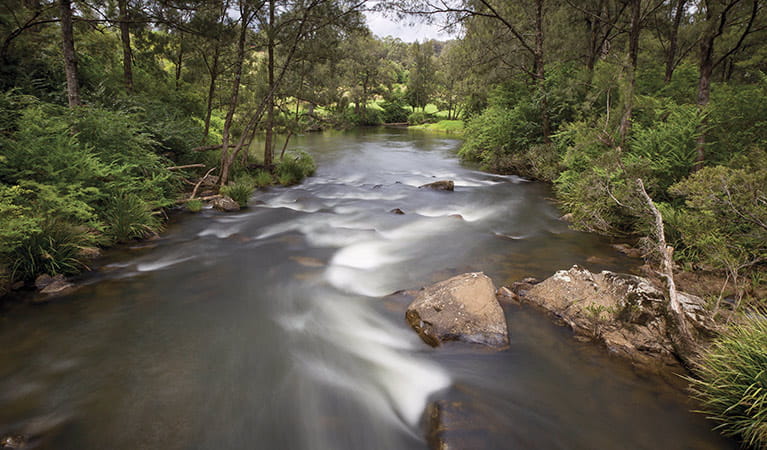
Nymboi-Binderay National Park is the traditional Country of the Gumbaynggirr People and their ancient connection to this land is evident throughout the park. The park's landscape provided a rich source of food, medicine and shelter for Aboriginal people and features strongly in cultural knowledge and Dreaming stories. As you travel through this park, take some time to think about the people who lived here and their strong attachment to this ancient landscape and all it contains.
Waterworld
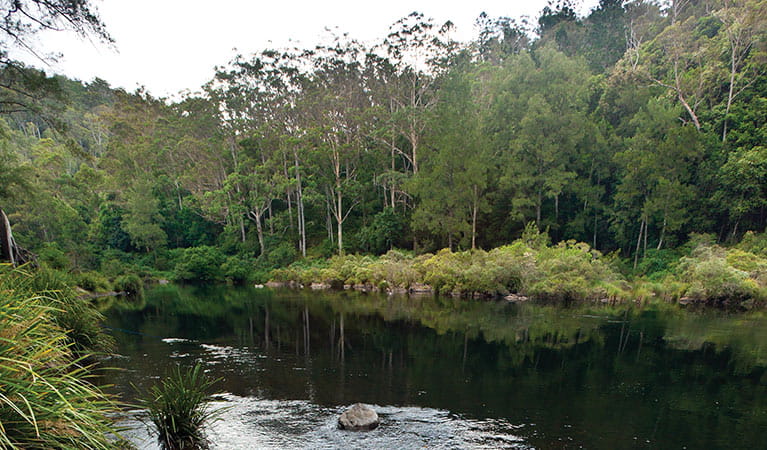
The Nymbodia River is a true highlight of Nymboi-Binderay National Park. The name of the park comes from Aboriginal language of the local Gumbaynggirr People; 'Nymboi' being their name for the river, and 'Binderay' meaning river. Rafting down the Nymboi River with an expert guide is an exhilarating experience and a fantastic way to take in the park's landscape.
- Coachwood loop track The Coachwood loop track is a short and easy walk that starts and finishes at the Norman Jolly picnic area in Nymboi-Binderay National Park.
- Moonpar Forest drive Moonpar Forest drive is a 75km scenic car touring route near Dorrigo. It’s a great day out and an ideal way to explore the walks, riverside picnic spots, and sights of Nymboi-Binderay and Cascade national parks.
Animal kingdom
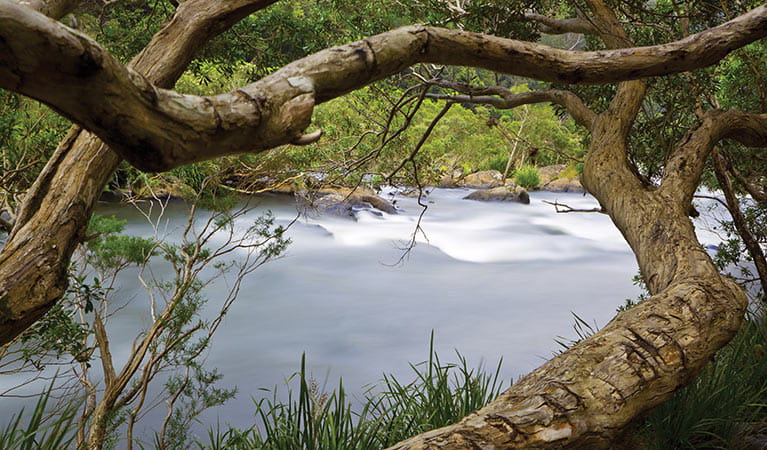
Nymboi-Binderlay has a diverse range of animals, including 68 types of mammal, 25 kinds of amphibian, 33 sorts of reptile and over 120 bird species; of these, at least 15 species are threatened. When you’re picnicking, camping or walking through the tallowwood and coachwood rainforests, be sure to keep your eyes open for the many native animals which call this place home.
- Moonpar Forest drive Moonpar Forest drive is a 75km scenic car touring route near Dorrigo. It’s a great day out and an ideal way to explore the walks, riverside picnic spots, and sights of Nymboi-Binderay and Cascade national parks.
- Norman Jolly picnic area Enjoy a picnic among tall old-growth trees and historic logging relics at Norman Jolly picnic area in Nymboi-Binderay National Park, not far from Dorrigo.
Plants and animals protected in this park
Animals
-
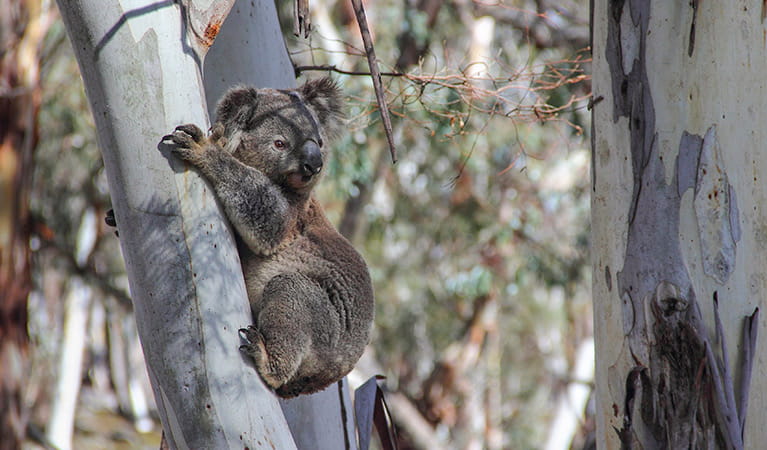
Koala (Phascolarctos cinereus)
One of the most renowned Australian animals, the tree-dwelling marsupial koala can be found in gum tree forests and woodlands across eastern NSW, Victoria and Queensland, as well as in isolated regions in South Australia. With a vice-like grip, this perhaps most iconic but endangered Australian animal lives in tall eucalypts within a home range of several hectares.
-

Superb lyrebird (Menura novaehollandiae)
With a complex mimicking call and an elaborate courtship dance to match, the superb lyrebird is one of the most spectacular Australian animals. A bird watching must-see, the superb lyrebird can be found in rainforests and wet woodlands across eastern NSW and Victoria.
-

Southern boobook (Ninox novaeseelandiae)
The southern boobook, also known as the mopoke, is the smallest and most common native owl in Australia. With a musical 'boo-book' call that echoes through forests and woodlands, the southern boobook is a great one to look out for while bird watching.
Plants
-
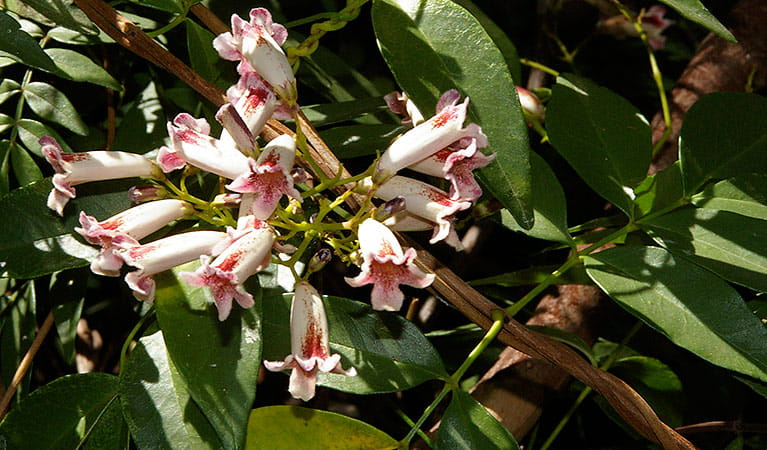
Wonga wonga vine (Pandorea pandorana)
The wonga wonga vine is a widespread vigorous climber usually found along eastern Australia. A variation of the plant occurs in the central desert, where it resembles a sprawling shrub. One of the more common Australian native plants, the wonga wonga vine produces bell-shaped white or yellow flowers in the spring, followed by a large oblong-shaped seed pod.
-
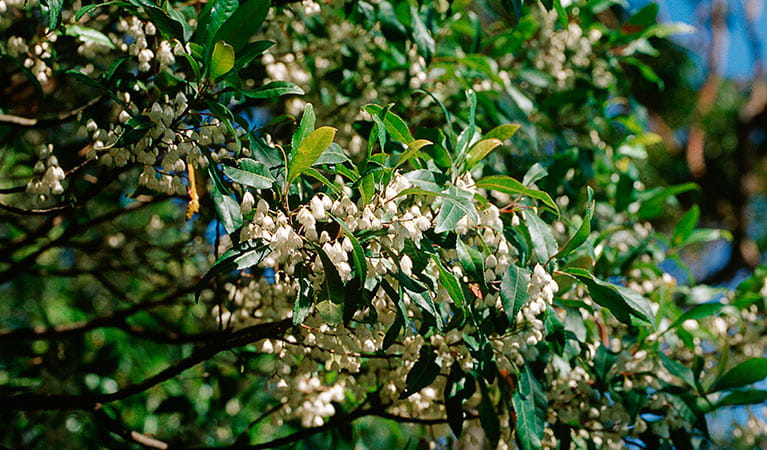
Blueberry ash (Elaeocarpus reticulatus)
The blueberry ash is a rainforest shrub which produces blue olive-shaped berries and spectacular bell-shaped flowers, which often appear on the plant together. It is a tall slender shrub or small tree found in rainforest, tall eucalypt forest and coastal bushland in eastern NSW, south-east Queensland and Victoria.
Environments in this park
Education resources (1)
What we're doing
Nymboi-Binderay National Park has management strategies in place to protect and conserve the values of this park. Visit the OEH website for detailed park and fire management documents. Here is just some of the work we’re doing to conserve these values:
Preserving biodiversity
Nymboi-Binderay National Park is home to endangered species, and protecting these is key to upholding the park’s biodiversity. Species monitoring, management and other conservation activities are ongoing in this park.
Managing weeds, pest animals and other threats
Pests and weeds have a significant impact to the ecosystems within Nymboi-Binderay National Park. NPWS carries out risk assessments for new and emerging weeds and works to control high priority weeds such as privet to protect biodiversity in this park.
Historic heritage in our parks and reserves
Visitors to Nymboi-Binderay National Park can see and experience a range of historic sites and important remnants of NSW’s early timber industry. NPWS is committed to conserving and interpreting these assets, and their assessment, monitoring and management are ongoing.
Conserving our Aboriginal culture
Aboriginal culture is of great value to NPWS, and the condition of Aboriginal sites is reviewed and upgraded as required in Nymboi-Binderay National Park. NPWS works closely with the Gumbaynggir Aboriginal community and local Aboriginal land councils with regards to researching, acknowledging and maintaining Aboriginal heritage in this park, and Aboriginal cultural values are assessed and incorporated into park management decisions.
Managing fire
NSW is one of the most bushfire prone areas in the world as a result of our climate, weather systems, vegetation and the rugged terrain. NPWS is committed to maintaining natural and cultural heritage values and minimising the likelihood and impact of bushfires via a strategic program of fire research, fire planning, hazard reduction, highly trained rapid response firefighting crews and community alerts.

